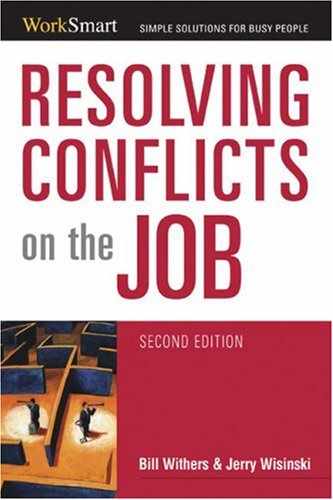There are many books to choose from that can help you to keep thinking about conflict on the job. This short list can be a springboard to other reading or—better yet—to your trying some new ideas and actions on for size.
The best first book for learning about negotiation is still Getting to Yes: Negotiating Agreement Without Giving In by Roger Fisher, William Ury, and Bruce Patton. It is direct and to the point, and it is a very good how-to manual for what we call assertive behavior in this book.
Jay Rothman’s book Resolving Identity-Based Conflict in Nations, Organizations, and Communities digs into the role that identity plays in seemingly impossible conflicts and makes practical suggestions for engagement.
This book is designed to help you to think about conflict in new ways and to help you be ready as you engage in a difference with another person. Many of the skills we need when we come to the table are parallel to those that are used by mediators. The following resources can help you to learn about mediation and give you new ways to approach others:
Jennifer E. Beer’s The Mediator’s Handbook is used as a training text by mediators around the world. It is a handy book to reach for when preparing for any difficult conversation.
The Promise of Mediation: Responding to Conflict Through Empowerment and Recognition by Robert A. Baruch Bush and Joseph P. Folger offers ideas to help us to shift our thinking about conflict from a contest to be won to an opportunity for learning.
The website www.mediation.com has monthly articles by and for people interested in mediation.
How we think about work and our coworkers plays a big part in how we think about and engage in workplace conflict. Still fresh after nearly fifty years is Douglas McGregor’s landmark book The Human Side of Enterprise. This book is a good reminder for us to check to see if the actions we choose—especially as managers—are consistent with what our beliefs are. As you read this book, you will recognize a lot of the thinking that has become a part of the ideal of how best to work with others. As Warren Bennis wrote in his foreword to the twenty-fifth-anniversary printing, “Much of the work that goes on now could not have happened if this book hadn’t been written.”
When I am asked what one book people should read about work, the answer has for many years been The Fifth Discipline: The Art and Practice of the Learning Organization by Peter Senge. The book is packed with sometimes daunting ideas. If you aren’t quite ready to jump into the whole work, start with the fourth chapter, “The Laws of the Fifth Discipline,” then flip to the index, look up “dialogue,” and read those entries. If what you find there makes sense to you, think about what else you need to learn to be able to apply it to your work.
Finally, think of yourself when you are at your best. What do you do that works for you and the others with whom you come in contact? Make a list and carry it around for a few days. Add to it. Think about it. Live with it. Then take out another piece of paper, set it beside your list, and write down what new things you can do to be at your best at all times.
Have fun.
